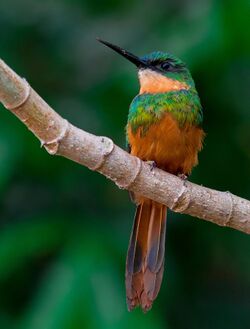Biology:Rufous-tailed jacamar
| Rufous-tailed jacamar | |
|---|---|

| |
| Female, Brazil | |
| File:Galbula ruficauda - Rufous-tailed Jacamar XC250855.mp3 | |
| Male G. r. rufoviridis in the Pantanal, Brazil , and a recording from Ecuador | |
| Scientific classification | |
| Domain: | Eukaryota |
| Kingdom: | Animalia |
| Phylum: | Chordata |
| Class: | Aves |
| Order: | Piciformes |
| Family: | Galbulidae |
| Genus: | Galbula |
| Species: | G. ruficauda
|
| Binomial name | |
| Galbula ruficauda Cuvier, 1816
| |

| |
The rufous-tailed jacamar (Galbula ruficauda) is a near-passerine bird which breeds in the tropical New World in southern Mexico, Central America and South America as far south as southern Brazil and Ecuador.
Description
Like other jacamars they are elegant, brightly coloured birds with long bills and tails. The rufous-tailed jacamar is typically 25 cm (10 in) long with a 5 cm (2 in) long black bill. The subspecies G. r. brevirostris has, as its name implies, a shorter bill. This bird is metallic green above, and the underparts are mainly orange, including the undertail, but there is a green breast band. Sexes differ in that the male has a white throat, and the female a buff throat; she also tends to have paler underparts. The race G. r. pallens has a copper-coloured back in both sexes.
Food and foraging
This insectivore hunts from a perch, sitting with its bill tilted up, then flying out to catch flying insects. One commonly preyed upon insect is the social wasp Agelaia vicina. Other insect prey include flies, beetles, bees, dragonflies, and butterflies.[2] Further, the bird distinguishes between edible and unpalatable butterflies mainly according to body shape.[3]
Nesting
This species is a resident breeder in a range of dry or moist woodlands and scrub. The two to four rufous-spotted white eggs are laid in a burrow in a bank or termite mound.
Vocalizations
The rufous-tailed jacamar's call is a sharp pee-op, and the song a high thin peeo-pee-peeo-pee-pe-pe, ending in a trill.
Bibliography
- ffrench, Richard (1991). A Guide to the Birds of Trinidad and Tobago (2nd ed.). Comstock Publishing. ISBN 0-8014-9792-2.
- Hilty, Steven L (2003). Birds of Venezuela. London: Christopher Helm. ISBN 0-7136-6418-5.
References
- ↑ BirdLife International (2020). "Galbula ruficauda". IUCN Red List of Threatened Species 2020: e.T22682200A163585918. doi:10.2305/IUCN.UK.2020-3.RLTS.T22682200A163585918.en. https://www.iucnredlist.org/species/22682200/163585918. Retrieved 20 November 2021.
- ↑ "Galbula ruficauda (Rufous-tailed Jacamar)" (PDF). https://sta.uwi.edu/fst/lifesciences/sites/default/files/lifesciences/documents/ogatt/Galbula_ruficauda%20-%20Rufous-tailed%20Jacamar.pdf.
- ↑ Chai, Peng (1996). "Butterfly visual characteristics and ontogeny of responses to butterflies by a specialized tropical bird". Biol. J. Linn. Soc. 59 (1): 37–67. doi:10.1111/j.1095-8312.1996.tb01452.x.
External links
- Rufous-tailed jacamar videos, photos & sounds in the Internet Bird Collection
- Rufous-tailed jacamar photo gallery VIREO
- Stamps[Usurped!] (for British Honduras-(Belize), Guyana, and Nicaragua)
- Photo-High Res; Article, Tsgcs.co.uk
Wikidata ☰ Q765770 entry
 |





